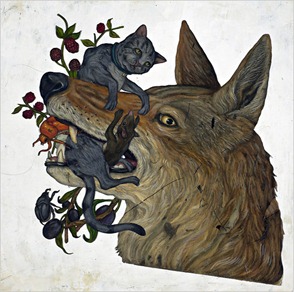I had one of those rare moments of quiet synchronicity the other day when I was doing the recycling. In a pile of newspapers I noticed an old article from the New York Times, which stood out because of this amazing accompanying art by Jason Holley.
The article is about the tenacity of Coyote, about how he’s breeding with wolves to make meaner, fitter pups and about – and this is the thing I wanted to share with you – how he works with Badger to feast on poor Ground Squirrel and his family. In a nutshell, Coyote’s not so good at digging, so he lets Badger delve into Ground Squirrel’s burrows. When Ground Squirrel breaks cover, Coyote chases him down at a speed Badger couldn’t hope to match. The pair share the carcass, even though in other circumstances Coyote and Badger might be the ones fighting each other. This incredibly jaunty video best demonstrates what goes on.
Now here’s the thing: I’d just been reading a Hopi folk story called Coyote and Badger. It’s a neat expression of the uneasy relationship between the two animals, because after going out hunting for food together, Badger dupes Coyote into killing himself. Coyote’s a really interesting character in these Native American stories. He’s like the fox in European folklore, a trickster figure who can be both crafty and a buffoon. You can read a version of the story online here.
If you like Coyote, I’d heartily recommend an excellent essay by Terri Windling. Here’s a snippet that sums up the dynamic at the heart of trickster stories.
In the oral tradition, Coyote stories are marked by their combination of outrageous (sometimes X–rated) humor and elements of great profundity; they are stories in which the sacred and profane are tied ineluctably together. “They are funny stories,” a Navajo friend tells me, “but they are also sacred and serious. Trickster reminds us not to be too simplistically dualistic in our thinking; that good can come out of bad and vice versa; and that right and wrong are not always poles apart.”
Windling’s is an entertaining and comprehensive look at trickster figures from around the world, from Coyote to Anansi to Shakespeare’s Puck. Her closing remarks about 21st century tricksters and the eventual emergence of female trickster figures are fascinating: I would suggest that this is one such example.
And this one is slightly less controversial…

Great work keep it coming, best blog on earth
Wended my way here from the jacket blurb of The Girl with Glass Feet, and very glad I did. That Terri Windling essay is indeed excellent. And I like the idea of Gaga-as-trickster… though I’m not sure I’ll ever be able to overcome my horror of the meat dress. 🙂 Looking forward to reading more of your blog!
Thanks Sarah! I’ve become pretty much convinced that Gaga is Coyote. Now I just need to work out who the Badger of the pop world is…